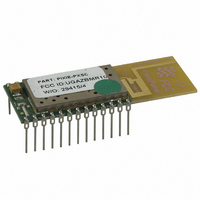PIXIE-DIL-PXSC Flexipanel, PIXIE-DIL-PXSC Datasheet - Page 5

PIXIE-DIL-PXSC
Manufacturer Part Number
PIXIE-DIL-PXSC
Description
MODULE ZIGBEE SW COORD 26-DIP
Manufacturer
Flexipanel
Series
Pixie™r
Specifications of PIXIE-DIL-PXSC
Frequency
2.4GHz
Modulation Or Protocol
802.15.4 Zigbee
Power - Output
0dBm
Voltage - Supply
2.1 V ~ 3.6 V
Current - Receiving
25mA
Current - Transmitting
25mA
Data Interface
PCB, Through Hole
Memory Size
64kB ROM, 3986B RAM
Antenna Connector
On-Board, Trace
Operating Temperature
-40°C ~ 85°C
Package / Case
26-DIP Module
Wireless Frequency
2.4 GHz
Interface Type
UART, SPI
Modulation
DSSS OQPSK
Security
APS, NWK, MAC, ZDO
Operating Voltage
+ 2.1 V to + 3.6 V
Output Power
1 mW
Lead Free Status / RoHS Status
Lead free / RoHS Compliant
Applications
-
Sensitivity
-
Data Rate - Maximum
-
For Use With/related Products
PIC18LF4620
Other names
658-1002-5
PIXIE-PXSC
PIXIE-PXSC
Available stocks
Company
Part Number
Manufacturer
Quantity
Price
Company:
Part Number:
PIXIE-DIL-PXSC
Manufacturer:
Flexipanel
Quantity:
135
Each end device can have up to 240 endpoints, which
are separate applications sharing the same radio. For
example, a three-gang light switch would have two
distinct endpoints sharing the same radio electronics
and battery.
The coordinator also manages the Binding Table This
saves an endpoint such as a light switch from knowing
which other endpoints (i.e. light) it is connected to. The
coordinator, and possibly the routers, store this
information for the end devices in a lookup table.
Endpoints are associated by adding entries to this
lookup table in a process known as binding (Figure 5).
FlexiPanel Ltd has a continuing program of firmware
development for Pixie devices. In general, firmware is
provided free for use with Pixie devices.
p5
Figure 5. Binding connects compatible ZigBee endpoints to
each other. The coordinator stores the binding table.
Cupboard
Endpoint
Router
Coordinator
Kitchen
Garden
17-Mar-08
Hall
Star
Figure 4. Endpoints are allowed to sleep, while routers can store messages
for them. In addition, routers can pass messages alone the network.
The coordinator is a router that also has a network management role.
Pixie DS481-17
Tree
Back
door
Cluster
Front
door
Kitchen
door
Cupboard
© FlexiPanel Ltd
The ZigBee Stack
The ZigBee stack is loosely based on the Open
Systems Interconnection model. Referring to figure 6,
the basic tasks of each layer in the stack are as follows:
Physical Layer (PHY): The PHY layer consists of a half
duplex IEEE 802.15.4 radio transceiver. Pixie uses the
16-channel 2.4GHz ISM band, which is the most widely
accepted worldwide.
Medium Access Control (MAC):
provides reliable, error-free communications between a
node and its immediate neighbors.
Network Layer (NWK): The NWK layer provides the
routing and multi-hop capability required to turn MAC-
level communications into a star, tree or mesh network.
Application Support Layer (APS): The APS layer routes
messages on the network to the different application
end points on the node.
Applications Objects:
software at an endpoint which achieves what the device
is designed to do.
ZigBee Device Object (ZDO): The ZDO is a special
application
management, security keys and security policies. Its
ZigBee Device Profile (ZDP) is always end point zero,
while other application end points are numbered 1 to
240.
Security Services: The security services provided for
establishing and exchanging security keys to secure the
communications. The MAC, NWK and APS layers use
them for encrypting data prior to transmission and
authenticating it when it is received.
Firmware Development guide
In most applications, nodes will be divided into full
function devices (FFDs) implemented on Pixie modules
and reduced function devices (RFDs) implemented on
lower-cost
coordinators need to be mains-powered FFDs, whereas
Patents may apply and/or pending
Application
object 1
IEEE 802.15.4 defined
ZigBee Alliance defined
Application developer defined
Application endpoint
Pixie
object
Manages connections between applications objects
Manages multi-hop network communications
MAC - Medium Access Control
APS - Application Support
Reliable communications between neighbors
Application
object 2
2.4GHz or 868/915MHz transceiver
Lite
NWK - Network
responsible
PHY - Physical
Application
An application object is the
object ...
modules.
Application
object 240
for
The IEEE 802.15.4
www.FlexiPanel.com
/ ZigBee stack
The MAC layer
Figure 6:
overall
ZigBee Device Object
(Application Object 0)
Device management
Routers
ZDO
device
and




















